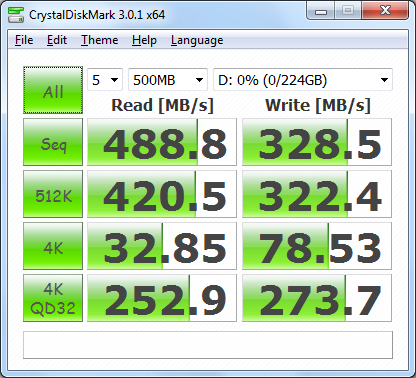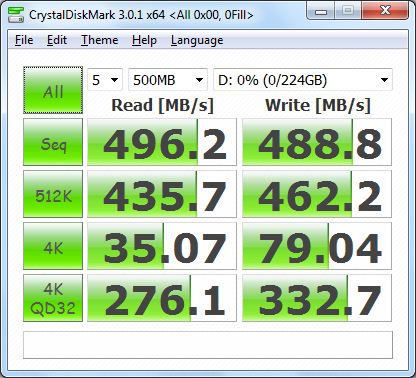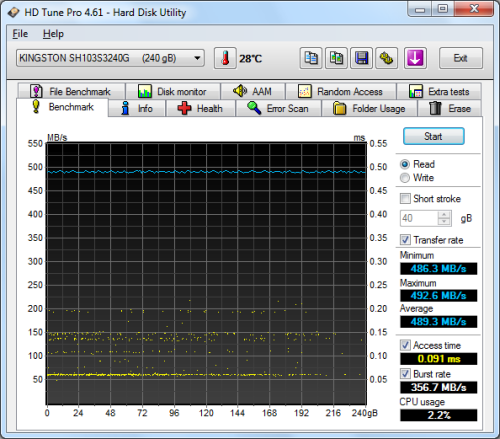![]()
![]()
Model: Silicon Power Slim S70 240GB Solid State Drive
Manufacturer: Silicon Power
Provided By: Silicon Power
Silicon Power is a relatively new name in the storage industry. Founded in 2003 by a group of professionals specializing in international business, global marketing and technical engineering, the company has already established itself as one of Taiwan's top manufacturers. With an eye for attractive and versatile design, Silicon Power has built its brand around the concept that its customers deserve products that represent who they are in life and mirror their personality. The end result is a variety of uniquely designed storage products including USB flash drives, memory cards and solid-state drives (SSD).

This fall, Silicon Power launched its new Slim series SSDs. Designed for the new generation of ultra slim notebooks, the S60 and S70 are only 7mm in height and weigh in at a mere 63g. The two drives are powered by LSI's SandForce SF-2281 processor and feature a SATA 6GB/s interface, native TRIM support and DuraWrite technology. From here though, the similarities end. Where the S60 is aimed at the cost conscious consumer, the S70 is equipped with synchronous NAND flash and an optimized firmware to deliver superior performance. The S70 is also more durable and reliable and can endure more write cycles than its sibling.
For this review, Silicon Power sent us the 240GB version of the Slim S70. This SSD is capable of delivering up to 557 MB/s sequential read and 507 MB/s sequential write speeds as well as a maximum of 86,000 4K random write IOPS.
| Silicon Power Slim S70 240GB Solid State Drive | |||||||||||||||||||||||||||
General Specifications
Performance
Environmental
Dimensions and Weight
Other Features
|
Needless to say, this is only a taste of what the Slim S70 has to offer. To give you an idea of what to expect, we'll take a closer look at Silicon Power's new SSD and then see how well it performs. Does the S70 have what it takes? Can it deliver the value and performance we've come to expect from Silicon Power? Keep reading as we find out.
The Slim S70 comes in a brightly colored box. Along with a picture of the drive, the front advertises many of its key features including its 240GB capacity, SATA III interface and 7mm ultra-slim form factor. The back of the box provides a bit more information, including the S70's specifications and a longer list of features. Inside, you'll find the SSD, mounting screws and a small installation guide.
![]()
Physical Features:
The S70 shares the same basic design as Silicon Power's Velox V70 series SSD. The entire casing is made out of aluminum. The top and sides of the drive are champagne gold in color and have a nice, brushed metal finish. The bottom of the S70 isn't nearly as flashy. Instead of brushed aluminum, Silicon Power opted for a plain, matte black finish.
![]()
![]()
The biggest difference between the S70 and the Velox V70 is the height of the two drives. Where the V70 is your standard 2.5" SSD with a height of 9.5mm, the S70 sports a new, ultra-slim form factor. At 7mm in height, the drive can be installed in ultrabooks as well as standard laptops and desktop PCs.
![]()
Like Silicon Power's Velox V30, V60 and V70 series SSDs, the S70 uses SandForce's SF-2281 controller chip. The SF-2281 can be found in a number of other SSDs including the ADATA XPG SX900, Corsair Force Series, OWC Mercury 6G, OCZ Vertex 3, Patriot Pyro SE, Kingston HyperX and the SanDisk Extreme.
![]()
![]()
If you've looked at Silicon Power's website, read their press release or looked at the box the S70 comes in, you've probably seen that the drive is equipped with "Toggle/Synchronous" flash. I find this to be a bit misleading as it suggests that the drive uses Toggle-Mode NAND when in reality it's using Intel's 25nm synchronous NAND flash chips. Looking at the pictures above, you can see that there are eight 16GB 29F16B08CCME3 synchronous NAND flash chips on either side of the PCB. If you do the math, you'll see that this equals 256GB and not the 240GB of storage the drive advertises. The SandForce controller uses this extra 7% (16GB) to maximize read and write performance and extend the endurance and overall reliability of the drive.
The test system used in this review was an HP 8200 Elite. The computer came equipped with an Intel Core i5-2400 CPU, 4GB of DDR3 1333MHz memory, Seagate Barracuda 7200.12 ST3250312AS 250GB SATA 6 Gb/s hard drive, NVIDIA Quadro FX580 512MB PCIe graphics card and an Intel 82579-LM gigabit network card. For the operating system, I installed a fresh copy of Windows 7 Enterprise.
To test the performance of the Plextor PX-256M5P, I ran a series of benchmarks using CrystalDiskMark 3.0.1, HD Tach RW 3.0.4.0, ATTO Disk Benchmark 2.46, AS SSD, HD Tune Pro 4.61, Anvil's Storage Utilities and Iometer. For comparison, I've also included test results from the Plextor PX-256M5P, Kingston HyperX 3K, OCZ Vertex 3 3.5", Plextor PX-256M3P, SanDisk Extreme, Samsung 830 SSD, Plextor PX-256M3S and Patriot Pyro SE.
![]()
As I mentioned earlier, the S70 is based on SandForce's SF-2281 controller. Like other SandForce controllers, the SF-2281 features a technology called DuraWrite, which uses data compression to lower write amplification and extend the life of the drive by reducing the number of program-erase cycles. This data compression also plays a big part in the controller's performance. The more the data can be compressed, the faster an SSD like the S70 is able to read and write. Looking at the screenshot above, you can see that there is a considerable performance difference when writing incompressible (0%) and compressible (100%) data. However, thanks to the S70's synchronous NAND, its read speeds aren't affected nearly as much.
CrystalDiskMark 3.0.1:
First, I ran a few quick tests using CrystalDiskMark. This benchmark tool measures the performance of a storage device by testing its sequential read and write speeds as well as its random read and write speeds using blocks 512K and 4K in size.
According to Silicon Power, the S70 is capable of reading at 557MB/s and writing at 507MB/s when connected to a SATA 6 Gb/s port. The drive didn't come close to these numbers using CrystalDiskMark's default (random) test data. However, with the highly compressible 0x00 (0 Fill) data, the S70 was able to read at 497.1 MB/s and write at 490.0 MB/s.
HD Tach RW 3.0.4.0:
Next, I used HD Tach to test the S70's read, write and burst speeds as well as its seek times and CPU usage.
![]()
Looking at the screenshot above, you can see that the S70 had average read and write speeds of 393.7 MB/s and 386.9 MB/s respectively, as well as a burst speed of 335.2 MB/s.
ATTO Disk Benchmark 2.46:
I also used ATTO Disk Benchmark to test the S70's sequential read and write speeds. The tests are run using blocks ranging in size from 0.5KB to 8192KB and the total length set to 256MB.
When tested with ATTO, the S70's read speeds topped out at about 557 MB/s and its write speeds at 534 MB/s.
AS SSD:
AS SSD is a relatively new benchmark designed specifically for solid state drives. The application contains five synthetic tests used to determine the sequential and random read and write performance of a drive.
AS SSD also includes a copy benchmark. This test copies an ISO (two large files), program (many small files) and game (small and large files), returning the speed and duration of each.
HD Tune Pro 4.61:
Next, I ran a series of tests using HD Tune Pro. This hard disk utility measures a drive's performance by testing its sequential read and write speeds as well as its access time, burst rate and CPU usage. For this review, I'm also going to use it to benchmark the S70's random read and write speeds, random access times and the number of operations per second.
Silicon Power S70 240GB - HD Tune Write Benchmark |
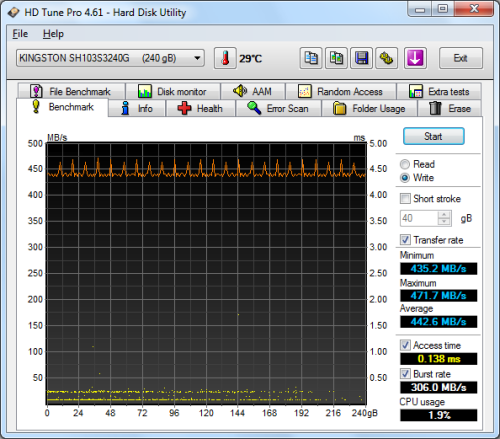 Kingston HyperX 3K 240GB - HD Tune Write Benchmark |
The S70 performed very well when benchmarked with HD Tune. The drive had average read and write speeds of 490.2 MB/s and 442.8 MB/s, respectively, and a burst rate of more than 369 MB/s when reading.
Silicon Power S70 240GB - HD Tune Random Access Read |
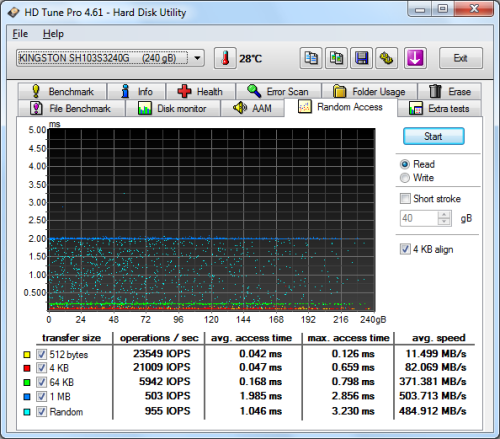 Kingston HyperX 3K 240GB - HD Tune Random Access Read |
Silicon Power S70 240GB - HD Tune Random Access Write |
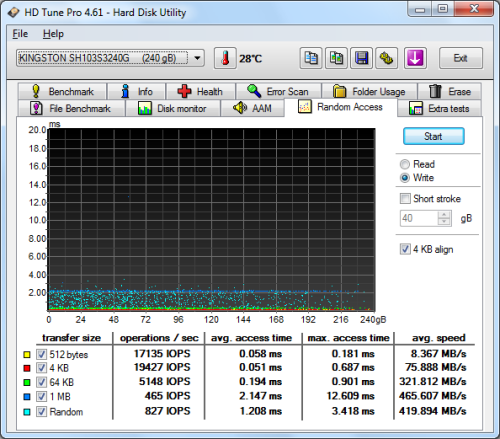 Kingston HyperX 3K 240GB - HD Tune Random Access Write |
The S70 didn't disappoint when doing random reads and writes. When writing 4KB blocks, the drive reached 22,317 IOPS and had an average speed of 87.178 MB/s. The S70 was slightly faster when reading, reaching 22,439 IOPS with an average speed of 87.653 MB/s.
Anvil's Storage Utilities:
Anvil's Storage Utilities is another new benchmark designed with SSDs in mind. The standard storage benchmark measures a drive's performance by testing its transfer speeds, access times and IOPS.
![]()
Silicon Power S70 240GB - Incompressible Data
![]()
Silicon Power S70 240GB - Compressible Data
Iometer:
Lastly, I ran a series of tests using Iometer. This tool can be configured to benchmark a number of things. In this case, I used it to measure the S70's read and write speeds and the number of operations per second. The tests were run using random bytes and a queue depth of 3.
![]()
The S70's performance was very similar to what we saw in our other tests. With highly compressible, repeating data, the drive was able to read at 529.35 MB/s and write at 506.52 MB/s. When tested with random data, the S70's read and write speeds dropped to 511.83 MB/s and 318.71 MB/s, respectively.
![]()
The S70 also performed very well when doing random reads and writes. With repeating data, the drive was able to read at 95.2 MB/s and write at a blazing 315.25 MB/s. Here too, the S70 took a performance hit when tested with random data. However, it was still able to write at 254.71 MB/s.
![]()
According to Silicon Power, the S70 can deliver a maximum of 86,000 IOPS when randomly writing 4K blocks. In our tests, the drive reached 80,704 IOPS with repeating data and 65,205 IOPS with random data.
TRIM Performance:
While SSDs offer many benefits, there are some downsides to using flash memory. One of the biggest issues people run into is performance degradation. Over time, an SSD will run out of fresh blocks and will have to write over data the file system has marked as deleted. This procedure is very complicated and can slow an SSD's write speeds considerably.
To address this problem, most manufacturers have added TRIM support to their SSDs. The TRIM command allows an operating system, such as Windows 7, to tell an SSD which data blocks are no longer in use. Using this information, the drive proactively erases these blocks and adds them to the free block pool.
![]()
I should point out that the S70 ships with SandForce's 5.0.3 firmware. Earlier releases of the Series 5 firmware had problems with TRIM, which are fixed in this version.
To test the S70's TRIM function, I first put the drive in a "dirty" state. I used Iometer to fill the entire drive and then ran a random write test for 20 minutes. Looking at the screenshot below, you can see that the S70's average read and write speeds dropped to 153.6 MB/s and 216.2 MB/s, respectively.
![]()
Silicon Power S70 240GB - Dirty
To see how well the S70 could recover, I let the computer sit for a few hours and then reran the test. The drive's average read speed jumped back up to 318.6 MB/s. However, its write speed lagged a bit behind, averaging out at 272.4 MB/s.
![]()
Silicon Power S70 240GB - After Trim
Lastly, I used an older version of OCZ's Toolbox utility (yes, it works) to perform a secure erase on the S70. With the drive wiped clean, its average write speed jumped back up to 395.6 MB/s.
![]()
Silicon Power S70 240GB - Wiped
Final Thoughts:
While SandForce-based SSDs are a dime a dozen these days, those capable of fitting in an ultra-slim notebook are still few and far between. With the Slim S70, Silicon Power has addressed the needs of this rapidly growing market. Along with a slim and stylish enclosure, the S70 combines LSI's SandForce SF-2281 controller with Intel's 25nm synchronous NAND flash to deliver some impressive performance. In our sequential read and write tests, the drive was able to read at speeds as high as 557 MB/s and write at speeds in excess of 490 MB/s. It also performed very well in our random write tests, delivering more than 80,000 IOPS. As with other SandForce drives, the S70's performance did take a hit when reading and writing incompressible data. However, thanks to its synchronous NAND flash, its performance didn't suffer nearly as much as some other drives.
That being said, I do have a few issues with the S70. First and foremost, is the lack of firmware updates on Silicon-Power's website. I can only imagine that this is the company's way of preventing people from flashing their drive and potentially losing their data but anyone who has owned a SandForce-based SSD knows how important firmware updates can be. Silicon Power also needs to be clearer regarding the type of NAND flash used in their drives. In the case of the S70, the company makes reference to "Toggle/Synchronous" flash in its promotional materials and even lists it as a feature on the box. Like many, I took this to mean that the drive used Toggle-Mode NAND and was a bit surprised to find that wasn't the case.
The Slim S70 is currently listed on Amazon but is not yet in stock at the time of this review (Update: the 120GB and 480GB versions are now in stock). Prices currently range from $120 up to $433, with the 240GB version reviewed here listed at $210. These prices are a little higher than other SandForce-based SSDs. However, I'd expect them to come down to about where the Velox V70 is currently at once the S70 starts to ship.
Highs:
- Available in 60GB, 120GB, 240GB and 480GB capacities
- Slim 7mm form factor
- SandForce SF-2281 processor
- Excellent sequential read and write speeds
- SATA 6Gb/s interface
- Synchronous NAND flash
- Supports SMART, TRIM and Garbage Collection
- Equipped with DuraWrite and wear leveling
- Good looking and well constructed design
- 3 year warranty
Lows:
- Does not include a 2.5" to 3.5" adapter bracket
- Not as fast when writing incompressible data
- Hard to find in some markets
- Pricey
